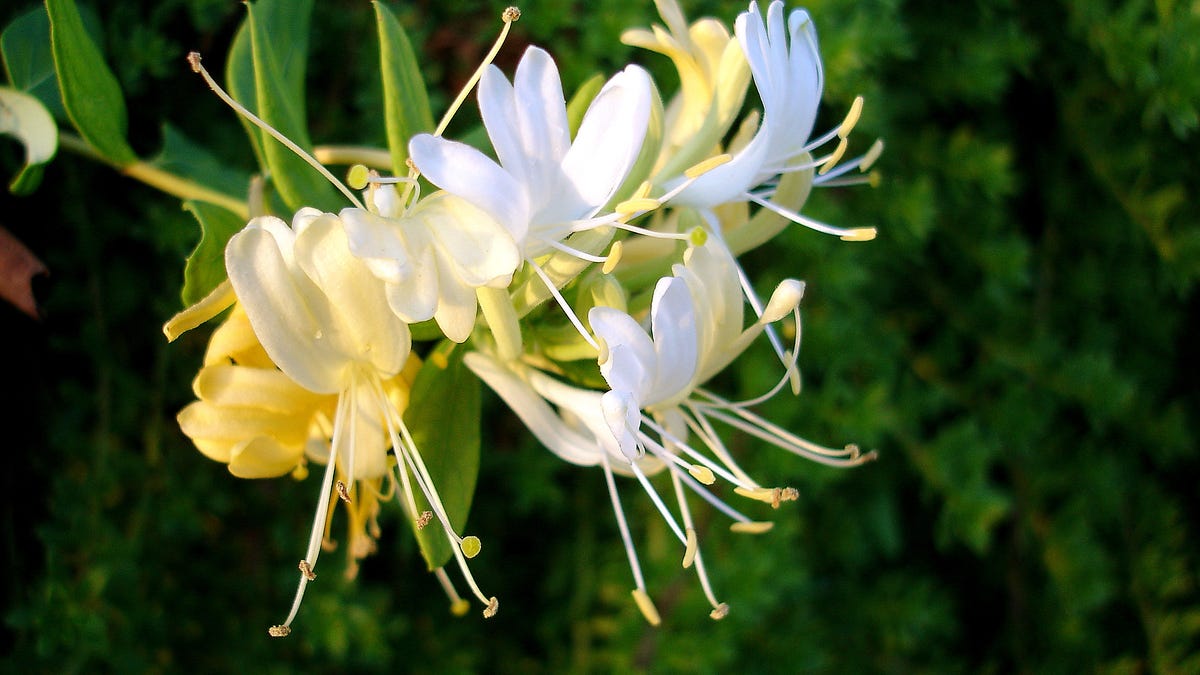 Why You Can Trust CNET
Why You Can Trust CNET Honeysuckle Is Sweet and a Secret Garden Killer. Here's How to Get Rid of It
Honeysuckle is really hard to remove, but we'll tell you how... before it kills the rest of your plants.

Honeysuckle looks pretty, smells great and kills all the plants near it.
Honeysuckle is deceptive: It looks pretty, smells sweet... and slowly kills all the plants around it. To be more specific, I'm talking about Japanese honeysuckle and bush honeysuckle. They're invasive in North America, and depending on the region in which you live, they can seriously disrupt whole ecosystems.
I didn't care about honeysuckle until I started gardening and maintaining the creek that runs through my yard a little more intentionally. It was there that I realized our willow tree -- which was a huge selling point of our house when we bought it -- was getting strangled by the vine. And everything beneath the willow was getting shaded out by the bush honeysuckle.
After talking to neighbors, one of whom we discovered was a professional gardener, we learned how to take the honeysuckle to task. Here's how to kill invasive honeysuckle once and for all. For more, you can try these expert-approved tips on changing your hydrangeas color and learn how to plant a tree the right way.
What you'll need to get rid of honeysuckle
You'll need three basic tools to take care of your honeysuckle problem:
- Pruning loppers (the largest you have).
- A power drill (with drill bits).
- Glyphosate-based weed killer (A tank with a hand pump will make it easier.)
I linked the products I use above, except for the herbicide, which I buy locally.
Yes, you do need herbicide
Many of you might already be getting worried about these recommendations, because they involve herbicide. I generally avoid using chemicals in my garden for a variety of reasons, and I first attempted to remove my own honeysuckle infestation without any poison at all.
But in many circumstances, doing so simply isn't possible or practical. If honeysuckle is well-established, digging it out can be a massive job -- and Japanese honeysuckle in particular is able to sprout from almost any piece of leftover plant. In my case, the roots of the Japanese honeysuckle were twined around the roots of the willow tree, so digging out the honeysuckle posed a significant risk of damaging the roots of the willow.
In short, using herbicide is not ideal, and you should be very careful with how you apply it. (Here's what to know about using weed killer around pets.) But honeysuckle can destroy ecosystems, too, so you may have to take the hit if you don't want significantly more work on your plate.
How to kill bush honeysuckle
In my experience, bush honeysuckle is the easier of the two invasive species to completely kill. Start by cutting the stems as low to the ground as you can -- that's why you'll want the largest pruner you have. These plants grow as a bush, so they'll often have multiple stems growing from one node. Next, use your power drill to drill holes directly into the freshly cut stems, going down into the center of the stem. Try to avoid breaking through the side of the stem: You're aiming to create a sort of well for the poison to sit inside.
Finally, use the hand pump to squirt the herbicide into the hole you just drilled, filling it to the top.
These are the stems of a bush honeysuckle that I poisoned two weeks ago. No new growth has emerged.
Glyphosate is a systemic herbicide, which means it will be translocated through the systems of the whole plant -- including into the roots and new sprouts -- so you want to be careful not to get it on other plants. Check back over the coming days and weeks, and if you see any new growth, you can repeat the process.
How to kill Japanese honeysuckle
Japanese honeysuckle is definitely the harder of the two species to completely eradicate -- especially if it's well-established -- because it can have long root systems with distant nodes that will produce new sprouts and roots within days of being cut or damaged.
I started by cutting all the vines off the trees I was hoping to save, and pulling as many of them down as possible. It's a good idea to burn those vines, because they can sprout their own new growth quickly if you just leave them on the ground.
Then wait for a few days to see which nodes produce a lot of new growth. I discovered seven or eight egg-sized nodes on the surface of the ground that put out about a dozen new sprouts within a few days of cutting. Once you've identified the biggest growers, pull off and dispose of the new sprouts, drill into the node and apply the herbicide as before. Then repeat the process, keeping an eye out for more productive nodes to identify and poison.
How to keep honeysuckle away for good
Killing honeysuckle doesn't just take an afternoon: You have to be sure to stay on top of it so your work isn't immediately wasted by new growth. Spend a season keeping an eye on the problem area, identifying new risks and drilling and poisoning appropriately. The following season, you can dig up the poisoned root balls of the bush honeysuckle and pull up the root systems of the Japanese honeysuckle much more easily.
As long as you stay conservative and focused with the application of your herbicide, you shouldn't damage the ecosystem much -- and certainly not permanently. And you'll get that pesky honeysuckle out for good, so your favorite trees or border can flourish as never before.
Want more gardening tips? Check out my recommendations on how to start a vegetable garden or read up on our more general gardening and lawn tips.

